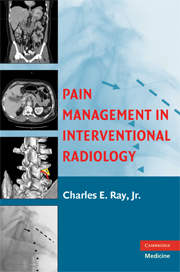Book contents
- Frontmatter
- Contents
- Contributors
- Preface
- Acknowledgments
- 1 Pain Management in Interventional Radiology: An Introduction
- 2 Clinical Evaluation of Low-Back Pain
- PART I LOCOREGIONAL PAIN CONTROL
- 3 Local Anesthetics
- 4 Functional Lumbar Spine Anatomy: A Review
- 5 Percutaneous Vertebroplasty
- 6 Kyphoplasty
- 7 Epidural Steroid Injections
- 8 Selective Nerve Root Blocks
- 9 Discography
- 10 Facet (Zygapophyseal) Joint Injections
- 11 Articular Interventions in Pain Management: A General Approach
- 12 Percutaneous Management of Visceral Pain
- 13 Embolization of Painful Neoplasms
- 14 Image-Guided Ablation of Painful Osteolyses
- 15 Chronic Pelvic Pain in Women
- PART II SYSTEMIC PAIN CONTROL
- Index
- References
14 - Image-Guided Ablation of Painful Osteolyses
from PART I - LOCOREGIONAL PAIN CONTROL
Published online by Cambridge University Press: 04 September 2009
- Frontmatter
- Contents
- Contributors
- Preface
- Acknowledgments
- 1 Pain Management in Interventional Radiology: An Introduction
- 2 Clinical Evaluation of Low-Back Pain
- PART I LOCOREGIONAL PAIN CONTROL
- 3 Local Anesthetics
- 4 Functional Lumbar Spine Anatomy: A Review
- 5 Percutaneous Vertebroplasty
- 6 Kyphoplasty
- 7 Epidural Steroid Injections
- 8 Selective Nerve Root Blocks
- 9 Discography
- 10 Facet (Zygapophyseal) Joint Injections
- 11 Articular Interventions in Pain Management: A General Approach
- 12 Percutaneous Management of Visceral Pain
- 13 Embolization of Painful Neoplasms
- 14 Image-Guided Ablation of Painful Osteolyses
- 15 Chronic Pelvic Pain in Women
- PART II SYSTEMIC PAIN CONTROL
- Index
- References
Summary
INTRODUCTION
In the past, strategies for the mitigation of tumor pain have been limited to surgery, radiotherapy, or pharmacotherapy. Unfortunately, in many cases, these strategies fail because of increased morbidity, poor patient tolerability, or incomplete pain palliation. Though often curative, surgical excision is limited to the few who are adequate surgical candidates. In addition, surgery for tumors involving or adjacent to critical neurovascular structures, such as the spine, can be associated with significant morbidity.
Radiotherapy is considered by some to be the standard of care for patients with localized bone pain; however, the maximum benefit of radiotherapy may not be realized until 12–20 weeks later, with 50% having no benefit within four weeks (1). Furthermore, some tumors are insensitive to radiation therapy, and as a result 20–30% of patients who receive radiation therapy fail to respond (2). Moreover, the risk of irradiating normal tissue prevents repeated cycles of radiation therapy from becoming an effective long-term treatment option.
Pharmacotherapy may reduce pain in some patients; however, side effects from both opioid and nonopioid analgesics can be intolerable. Likewise, toxicity and/or poor therapeutic response limit the effectiveness of chemotherapy.
More options are becoming available in the management of cancer pain. In particular, interventional radiology has much to offer with regard to percutaneous or minimally invasive techniques. Any means by which percutaneous, controlled tissue necrosis of targeted tissue can be achieved has potential application. In practice, the main percutaneous strategies employ thermal ablation (burning or freezing) or chemical ablation (dehydration).
- Type
- Chapter
- Information
- Pain Management in Interventional Radiology , pp. 217 - 231Publisher: Cambridge University PressPrint publication year: 2008



